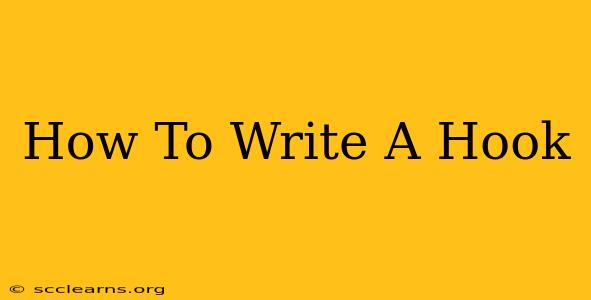Writing a captivating hook is crucial for any piece of writing, whether it's a blog post, a novel, or even a simple email. A strong hook grabs your reader's attention immediately and compels them to keep reading. Without a compelling hook, your brilliant writing might never get the chance to shine. This guide will walk you through several effective techniques to craft irresistible hooks that will leave your readers wanting more.
Understanding the Purpose of a Hook
Before diving into specific techniques, it's vital to understand the role of a hook. Its primary purpose is to engage the reader from the very first sentence. A good hook should:
- Spark curiosity: Make the reader wonder what will happen next.
- Create intrigue: Hint at something exciting or mysterious.
- Relate to the reader: Connect with their experiences or emotions.
- Set the tone: Establish the overall mood and style of your writing.
- Clearly signal the topic: Subtly hint at the main subject without being overly explicit.
Proven Hook Writing Techniques
Now let's explore some practical strategies for writing compelling hooks. Remember to tailor your approach to your specific audience and the type of writing you're producing.
1. The Question Hook
Start with a thought-provoking question directly related to your topic. This instantly engages the reader by inviting them to consider the answer. For example:
- Instead of: This blog post is about the benefits of meditation.
- Try: Are you constantly feeling stressed and overwhelmed? Learn how meditation can transform your life.
2. The Statistic Hook
A surprising or shocking statistic can grab attention quickly. Use a credible source to back up your claim. For example:
- Instead of: Climate change is a serious issue.
- Try: Did you know that over 70% of scientists agree that climate change is primarily caused by human activity? Let's explore the urgent need for action.
3. The Anecdote Hook
Begin with a brief, captivating story or anecdote related to your topic. This humanizes your writing and creates an immediate connection with the reader. For example:
- Instead of: This article explains the importance of saving money.
- Try: I remember the sinking feeling in my stomach when my car broke down, and I realized I couldn't afford the repairs. That experience taught me the crucial lesson of saving money.
4. The Bold Statement Hook
A strong, declarative statement that challenges assumptions or offers a unique perspective can be very effective. However, be prepared to back up your assertion with strong evidence. For example:
- Instead of: Working from home has its advantages and disadvantages.
- Try: Working from home is the future of work, and here's why.
5. The Problem/Solution Hook
Start by highlighting a common problem your readers face and then suggest your writing will offer a solution. This instantly shows relevance and value. For example:
- Instead of: This article discusses different ways to improve your sleep.
- Try: Are you constantly tired and struggling to get a good night's sleep? Discover proven strategies to improve your sleep quality tonight.
Refining Your Hook
Once you've written a hook, revise and refine it. Consider:
- Clarity: Is your hook easily understandable?
- Conciseness: Is it brief and to the point?
- Relevance: Does it accurately reflect the topic of your writing?
- Engagement: Does it make the reader want to learn more?
By mastering the art of writing compelling hooks, you can significantly improve the effectiveness of your writing and increase your chances of capturing your readers' attention and keeping them engaged from start to finish. Remember to practice different techniques and find what works best for your unique style and audience.

